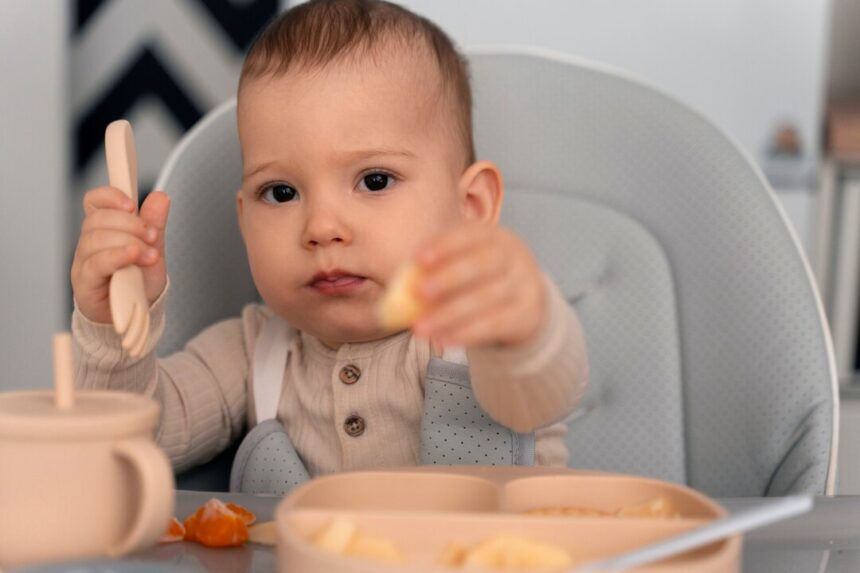Baby-led weaning (BLW) is an approach to introducing solid foods to infants that emphasizes self-feeding and exploration. Unlike traditional spoon-feeding methods, which involve purees and spoon-feeding by the caregiver, baby-led weaning allows babies to feed themselves from the start, promoting independence, fine motor skills, and a positive relationship with food. Let’s delve into the principles, benefits, and practical tips for implementing baby-led weaning with your little one.
The Principles of Baby-Led Weaning:
- Self-Feeding: Baby-led weaning encourages babies to feed themselves using their hands and explore a variety of foods at their own pace. This approach allows infants to develop hand-eye coordination and fine motor skills while learning to regulate their appetite and satiety cues.
- Family Meals: Baby-led weaning involves including infants in family mealtimes from the beginning, allowing them to observe and mimic the eating behaviors of older family members. This promotes social interaction, bonding, and exposure to a diverse range of foods and flavors.
- Texture Exploration: Instead of starting with purees and gradually progressing to solid foods, baby-led weaning introduces infants to age-appropriate finger foods and soft, easily graspable textures right from the start. This encourages chewing and helps babies develop the oral motor skills necessary for safe and effective eating.
- Responsive Feeding: Baby-led weaning emphasizes responsive feeding, where caregivers trust their baby’s cues and appetite to guide feeding interactions. Instead of coaxing or pressuring babies to eat a certain amount or type of food, caregivers offer a variety of nutritious options and allow infants to decide how much and what to eat.
Benefits of Baby-Led Weaning:
- Promotes Self-Regulation: Baby-led weaning allows infants to regulate their food intake based on hunger and fullness cues, promoting self-regulation and preventing overfeeding.
- Encourages Healthy Eating Habits: By offering a variety of whole foods from the start, baby-led weaning helps infants develop a taste for nutritious foods and fosters a positive relationship with food, reducing the likelihood of picky eating later on.
- Supports Development: Baby-led weaning promotes the development of fine motor skills, hand-eye coordination, and oral motor skills, laying the foundation for speech development and healthy eating habits in the future.
- Family Bonding: Including infants in family mealtimes promotes social interaction, bonding, and the development of cultural and familial food traditions.
Practical Tips for Baby-Led Weaning:
- Choose Age-Appropriate Foods: Offer soft, easily graspable finger foods such as steamed vegetables, ripe fruits, cooked grains, and strips of cooked meat or poultry. Avoid foods that pose choking hazards, such as whole grapes, nuts, popcorn, and raw vegetables.
- Supervise Carefully: Always supervise your baby closely during mealtimes and be prepared to intervene if necessary. Encourage safe chewing and swallowing by offering appropriately sized pieces of food and modeling safe eating behaviors.
- Be Patient: Baby-led weaning is a gradual process, and infants may take time to adjust to new textures and flavors. Be patient and allow your baby to explore and experiment with different foods at their own pace.
- Offer a Variety of Foods: Introduce a wide variety of nutritious foods to expose your baby to different flavors, textures, and nutrients. Include foods from all food groups, including fruits, vegetables, grains, protein-rich foods, and healthy fats.
- Follow Your Baby’s Lead: Pay attention to your baby’s cues and appetite, and respect their preferences and dislikes. Offer a balance of familiar and new foods and trust your baby to know how much and what to eat.
Baby-led weaning is a gentle, responsive approach to introducing solid foods that empowers infants to explore, experiment, and develop healthy eating habits from the start. By offering age-appropriate finger foods, promoting self-regulation, and including infants in family mealtimes, caregivers can support their baby’s development while fostering a positive relationship with food and nutrition. Whether you choose to follow baby-led weaning or a more traditional feeding approach, the key is to prioritize responsive feeding, trust your baby’s cues, and enjoy the journey of exploring food together.










